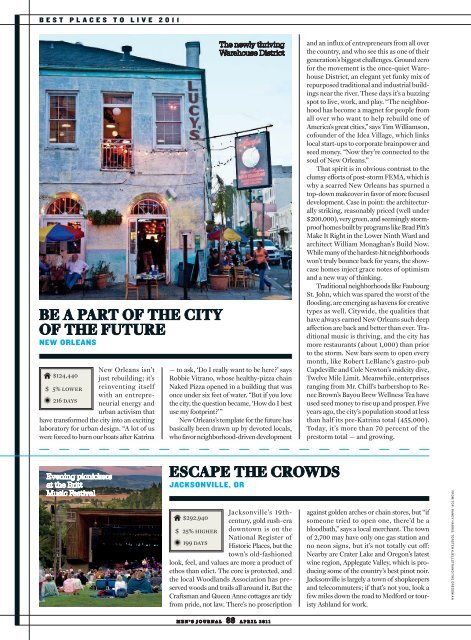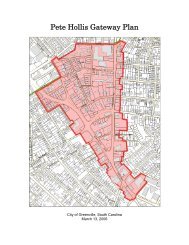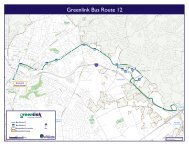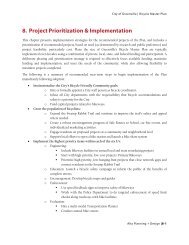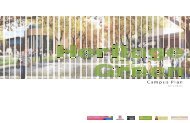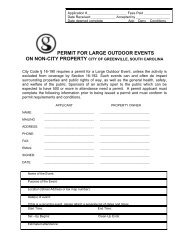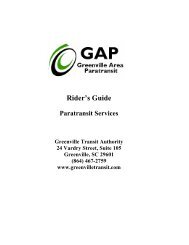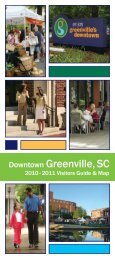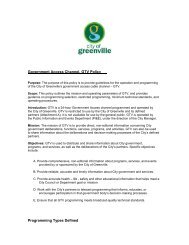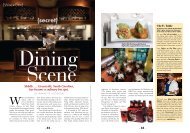Men's Journal - Upstate Forever
Men's Journal - Upstate Forever
Men's Journal - Upstate Forever
Create successful ePaper yourself
Turn your PDF publications into a flip-book with our unique Google optimized e-Paper software.
BEST PLACES TO LIVE 2011<br />
BE A PART OF THE CITY<br />
OF THE FUTURE<br />
NEW ORLEANS<br />
New Orleans isn’t<br />
$124,440<br />
just rebuilding; it’s<br />
$ 5% lower reinventing itself<br />
with an entrepreneurial<br />
energy and<br />
216 days<br />
urban activism that<br />
have transformed the city into an exciting<br />
laboratory for urban design. “A lot of us<br />
were forced to burn our boats after Katrina<br />
The newly thriving<br />
Warehouse District<br />
— to ask, ‘Do I really want to be here?’ says<br />
Robbie Vitrano, whose healthy-pizza chain<br />
Naked Pizza opened in a building that was<br />
once under six feet of water. “But if you love<br />
the city, the question became, ‘How do I best<br />
use my footprint?’ ”<br />
New Orleans’s template for the future has<br />
basically been drawn up by devoted locals,<br />
who favor neighborhood-driven development<br />
and an influx of entrepreneurs from all over<br />
the country, and who see this as one of their<br />
generation’s biggest challenges. Ground zero<br />
for the movement is the once-quiet Warehouse<br />
District, an elegant yet funky mix of<br />
repurposed traditional and industrial buildings<br />
near the river. These days it’s a buzzing<br />
spot to live, work, and play. “The neighborhood<br />
has become a magnet for people from<br />
all over who want to help rebuild one of<br />
America’s great cities,” says Tim Williamson,<br />
cofounder of the Idea Village, which links<br />
local start-ups to corporate brainpower and<br />
seed money. “Now they’re connected to the<br />
soul of New Orleans.”<br />
That spirit is in obvious contrast to the<br />
clumsy efforts of post-storm FEMA, which is<br />
why a scarred New Orleans has spurned a<br />
top-down makeover in favor of more focused<br />
development. Case in point: the architecturally<br />
striking, reasonably priced (well under<br />
$200,000), very green, and seemingly stormproof<br />
homes built by programs like Brad Pitt’s<br />
Make It Right in the Lower Ninth Ward and<br />
architect William Monaghan’s Build Now.<br />
While many of the hardest-hit neighborhoods<br />
won’t truly bounce back for years, the showcase<br />
homes inject grace notes of optimism<br />
and a new way of thinking.<br />
Traditional neighborhoods like Faubourg<br />
St. John, which was spared the worst of the<br />
flooding, are emerging as havens for creative<br />
types as well. Citywide, the qualities that<br />
have always earned New Orleans such deep<br />
affection are back and better than ever. Traditional<br />
music is thriving, and the city has<br />
more restaurants (about 1,000) than prior<br />
to the storm. New bars seem to open every<br />
month, like Robert LeBlanc’s gastro-pub<br />
Capdeville and Cole Newton’s midcity dive,<br />
Twelve Mile Limit. Meanwhile, enterprises<br />
ranging from Mr. Chill’s barbershop to Renee<br />
Brown’s Bayou Brew Wellness Tea have<br />
used seed money to rise up and prosper. Five<br />
years ago, the city’s population stood at less<br />
than half its pre-Katrina total (455,000).<br />
Today, it’s more than 70 percent of the<br />
prestorm total — and growing.<br />
Evening picnickers<br />
at the Britt<br />
Music Festival<br />
ESCAPE THE CROWDS<br />
JACKSONVILLE, OR<br />
Jacksonville’s 19thcentury,<br />
gold rush–era<br />
$292,940<br />
$ 25% higher downtown is on the<br />
National Register of<br />
199 days<br />
Historic Places, but the<br />
town’s old-fashioned<br />
look, feel, and values are more a product of<br />
ethos than edict. The core is protected, and<br />
the local Woodlands Association has preserved<br />
woods and trails all around it. But the<br />
Craftsman and Queen Anne cottages are tidy<br />
from pride, not law. There’s no proscription<br />
against golden arches or chain stores, but “if<br />
someone tried to open one, there’d be a<br />
bloodbath,” says a local merchant. The town<br />
of 2,700 may have only one gas station and<br />
no neon signs, but it’s not totally cut off:<br />
Nearby are Crater Lake and Oregon’s latest<br />
wine region, Applegate Valley, which is producing<br />
some of the country’s best pinot noir.<br />
Jacksonville is largely a town of shopkeepers<br />
and telecommuters; if that’s not you, look a<br />
few miles down the road to Medford or touristy<br />
Ashland for work.<br />
FROM TOP: RANDY HARRIS; TORSTEN KJELLSTRAND/THE OREGONIAN<br />
M E N ’ S J O U R N A L 88 A P R I L 2011


